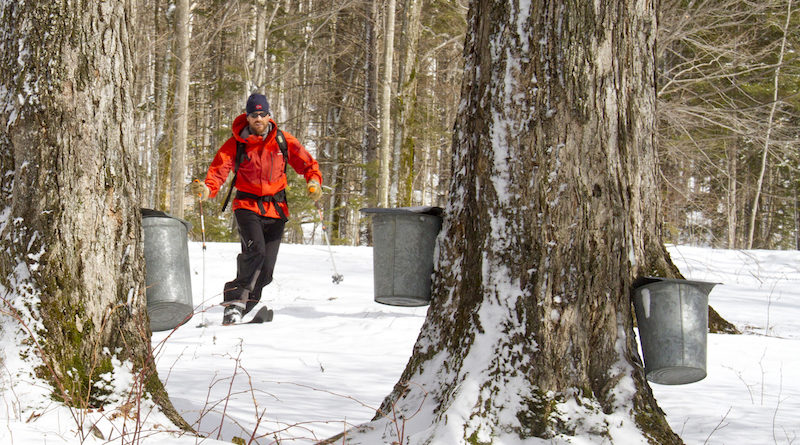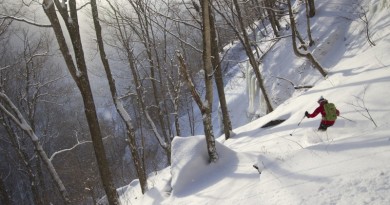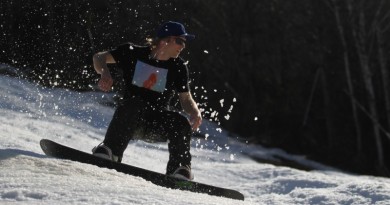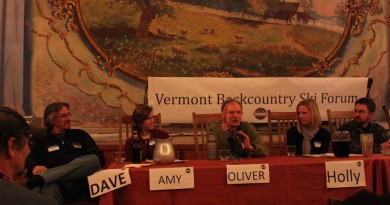When Corn Snow and Maple Syrup Collide
In the spring, Vermonters dream of corn snow and decadently sweet maple syrup.
It’s early March and the pre-dawn air is crisp. The woods are still and the snow is firm. Roger and Doug Brown pull on their Carhartt work vests, strap on their toolbelts, and strap skins onto their skis—
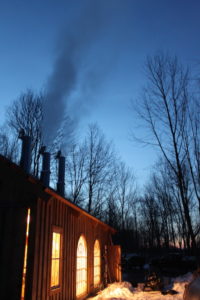
Doug, a pair of beat-up Volkls with alpine touring bindings and Roger, a telemark set-up.
Under the fading stars, they ski their way up the steep hill at Cochran’s Ski Area, following a clear tube. They check each place where it connects with an individual maple tree in their sugarbush. With sunshine and 40-degree temperatures in the forecast, they know two things: by the end of the day, they’ll be boiling maple sap for syrup and skiing buttery-soft corn snow.
The brothers, sons of Olympic gold medalist ski racer Marilyn Cochran Brown, are partners in Slopeside Syrup. The sugaring operation supplies maple syrup for UnTapped, a company the Browns launched in 2013 with pro cyclist Ted King and former Middlebury College Nordic ski coach Andrew Gardner. Today, UnTapped sells single-serve Maple Syrup Energy Gel packets (think Gu) for runners, skiers and endurance athletes. King and World Cup racer Robby Kelley (also a Cochran cousin) fuel with syrup when they race and swear by it. With traces of 50 antioxidants, amino acids and electrolytes such as calcium, riboflavin, manganese, zinc and potassium, maple syrup offers them an unprocessed alternative to energy gels.
While UnTapped may be new as a sports fuel, maple syrup has been energizing ski racers for generations at events like Stowe’s Sugar Slalom, one of North America’s oldest and longest-running alpine ski races. Originally founded in 1939 by the Mount Mansfield Ski Club, the race often attracts more than 1,000 racers—from World Cup competitors to tutu-clad nine-year-olds—and hundreds of spectators. At the bottom of the run, the ski racers are met with a treat: hot maple syrup boiled to a temperature of 235 degrees Fahrenheit, then poured over troughs of snow.
The sudden cold of the snow causes the syrup to curl on itself, making a pure maple taffy that kids scoop up with popsicle sticks. If you cut the intense sweetness with the classic sides—a bite of sour pickle or a plain cake donut—you’ll find the chewy candy has a warmth and freshness that belies its source: the nutrient-rich lifeblood of Vermont’s most iconic tree.
How it’s Made
During the winter, Vermont’s roughly 1,600 commercial sugarmakers work around the clock to drill new taps in each and every sugar maple in their plot, or sugarbush. They canvass the woods, visiting each and every tree, assessing its health and drilling a new hole to allow last year’s taphole to heal. Then they connect that “tap” to a network of plastic tubes that runs down to a main line that connects with their sugarhouse.
Come spring, the same cycles of freezing cold nights and warm, sunny days that turn November’s hard-pack base into March’s mashed potatoes and perfect corn snow kick the state’s sugar maples into action to produce gallons upon gallons of sap.
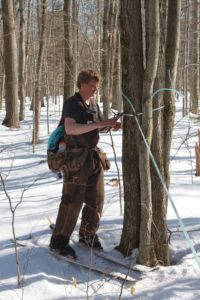
Before the watery, liquid sap is introduced to a massive evaporator, most commercial operations run it through a reverse osmosis machine, which allows as much as 75 to 80 percent of the water to be extracted before it is boiled in the evaporator, saving time and energy. As a general rule of thumb, it takes about 40 gallons of maple sap to produce a single gallon of pure maple syrup. Over the course of a season, the color and flavor profile of the syrup shifts, from the lightest “Grade A Golden Color and Delicate Taste” at the start, to “Grade A Dark Color and Robust Taste” to “Processing Grade” at the end.
Though modern technology like reverse osmosis allows larger commercial operations to either boil until just after dark, when the sap stops running, or to automate the process through the night, many sugarmakers, whether backyard hobbyists or small-scale producers, still man their evaporators through the wee hours of the morning as Vermonters have done since the 1700s.
They may invite friends and family to stack wood and feed the fire that fuels their evaporator (larger operations use gas). Kids skim foam off the surface of the hot sap. Some serve big meals and feed their neighbors as thanks for their help, inviting them to gather, local craft beers in hand, in the steamy, gently sweet air of the sugarhouse.
Then, for some sugarmakers, those late nights are followed by early mornings—on skis.
Skiers by Day, Sugarmakers by Night
“When you have that first spring ski run where it’s 45 degrees and sunny and you’re carving into perfect corn snow, you feel like you’re coming out of hibernation,” says Colton Blackman, who, with his wife Katie, owns and operates Killington-based First Chair Syrup. “The same can be said for sugaring. When you first fire up the evaporator, it’s usually a warm day. I like to step out onto the deck of the sugarhouse and listen to the forest, which is so quiet in the winter, start to wake up. There’s an energy in the air.”
The couple launched their operation in 2015 on a little sugarbush off of the Killington access road. Colton, 27 and Katie, 26, met as students at Woodstock Union High School. He was a Killington skier, she grew up skiing Mount Ascutney. After he earned his business degree and she hers in international affairs at George Washington University, they decided to move back to Vermont. The pair had both learned to sugar as part of an annual project at their respective elementary schools, using buckets and wood-fired evaporators. Today, Katie does marketing and sales for the company and Colton does the books—when they aren’t getting first chair at Killington Mountain Resort or skinning up for predawn laps before a day of collecting sap and checking their 400 taplines.
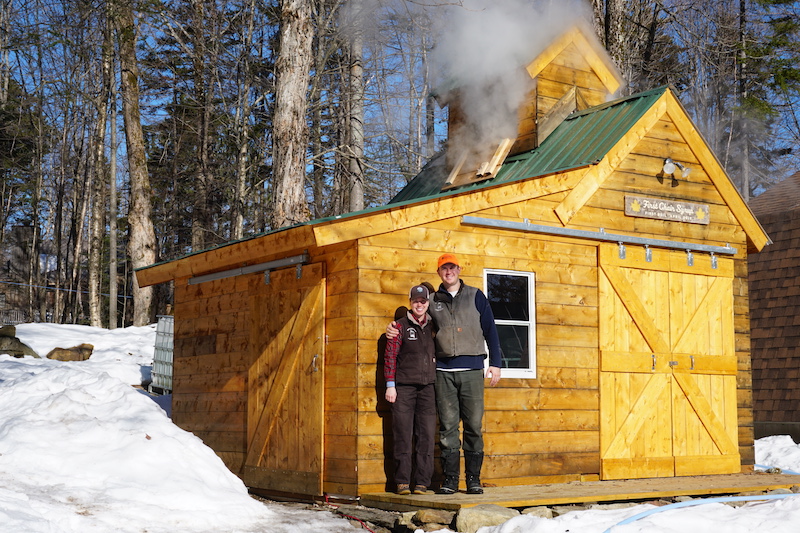
“It’s nice to get back to your roots,” says Colton of the move. “Skiing and making syrup are two things we’ve both been doing for as long as we can remember.”
Like the Cochrans, the Blackmans do much of their winter work on alpine touring gear. They haul tools and use climbing skins to work their way up their north-facing sugarbush. “I think the geography of Vermont lends itself to using skis to do this work. You climb to the top of a ridge, checking lines as you go, and ski back down.”
To the north, in the Mad River Valley, photographers Brian and Emily Mohr operate a small sugarbush on their property using just a few taps with sap buckets. The couple and their two young daughters grow much of their own food. Like many Vermont landowners, they sugar because it’s a great thing to do with little kids (collecting sap, tending the fire, tasting the syrup and labeling containers) and it makes them feel connected to their land.
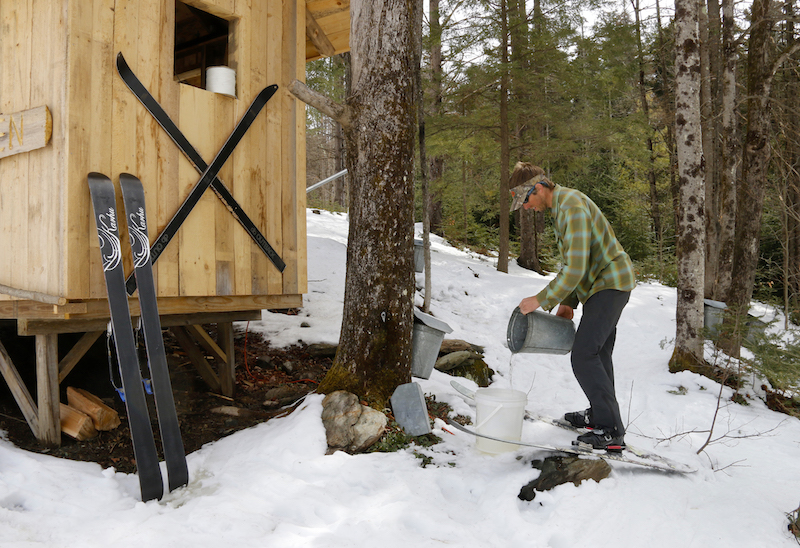
The sugar shack sits at the base of a small, homemade rope-tow in their backyard and the sugarbush sits at the top. “There’s not really a day that goes by during the snowy months when we are not out on skis, so skiing while we are sugaring seems totally natural for us,” says Brian, who skins up to check or retrieve buckets and skis down with sap. “Sugaring also tends to coincide with some of our favorite snow conditions of the season—corn snow—which freezes hard at night, but then softens in the spring by afternoon, offering smooth, buttery turns.” When the Mohrs boil sap, they usually build an outdoor fire and make an evening of it.
At Trapp Family Lodge in Stowe, you can cross-country ski through the von Trapp Family’s 2,000-tree sugarbush, and right up to the sugarhouse where, on spring days, wood smoke rises and sugarmakers Chris Pocher and Alex Femiac will offer skiers a taste of the newly-boiled syrup. At Trapps’, about 600 of the 1,400 trees in the sugarbush are tapped with old-fashioned buckets which hang from trees just off their 37 miles of groomed and 62 miles of backcountry cross-country ski trails. The commercial sugaring operation makes 500 to 700 gallons of syrup per year and taps some of the oldest sugar maples in the state. Some have tap scars that date back to 1850, when the land was part of an old dairy farm. The von Trapp family has been sugaring at the property since 1943, the first winter they spent there after immigrating from Austria.
the Maple Men from Dapp
When Sam von Trapp moved back to Vermont in 2007 to join the family business, he took over the sugaring operation, skiing between trees to manually gather sap in buckets for several years. “I was just coming off an eleven-year stint where I was doing two winters a year working in the ski industry—one in the southern hemisphere and one in the northern hemisphere,” says von Trapp, who uses waxless touring skis outfitted with Salomon X-Adventure bindings. “On shallower grades, I could fill up buckets and just glide back to the sugarhouse,” says von Trapp.
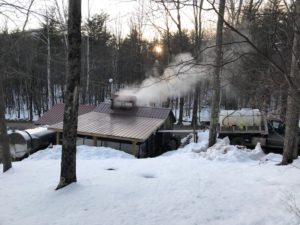
In East Dorset, Doug Zecher and his son Kyle run Havoc Hill Maple. Zecher has served as the director of ski patrol at Bromley Mountain for the last 30 years (he’s been on patrol for 52) and runs a 5,000-tap sugaring operation, producing about 2,000 gallons of syrup annually. He grew up and learned to ski on his parents’ 200-acre dairy farm in Manchester at the base of Bromley Mountain. He then studied maple sciences at the University of Vermont.
Today, he makes his living as a patroller, a sugarmaker, a property manager and a snowplow driver. “Every month is a different chapter,” he says.
“I love that, like farming, with sugaring and skiing I don’t do the same thing for long because the seasons change.”
Sugar & Snow
Nothing says spring like piping hot maple syrup on snow. When made perfectly, it produces a sweet, rich, lightly chewy candy that,
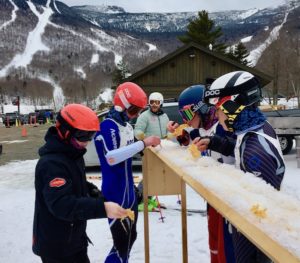
when paired with a salty, sour pickle spear, allows the maple’s floral and earthy undertones to shine through.
To make your own, heat syrup to 235 degrees Fahrenheit, or until a tablespoon gets a little bit tacky when you remove it from the heat. Drizzle the syrup in ribbons onto packed snow and watch it curl and harden into an amber taffy. Twirl it up with a spoon or roll it onto a popsicle stick and serve it in the Vermont way: with a savory pickle spear and old-fashioned, buttermilk donuts.
Across the state, there are lots of opportunities to sample sugar on snow, maple sugar and syrup in all its forms. Traditionally, each year many Vermonters open their sugarhouses to the public for demonstrations, samples, food, live music and more during the Vermont Maple Sugar Makers Association Maple Open House Weekend. And young ski racers (as shown above) look forward to sugar on snow at Stowe’s Sugar Slalom, a race that’s endured for generations.

